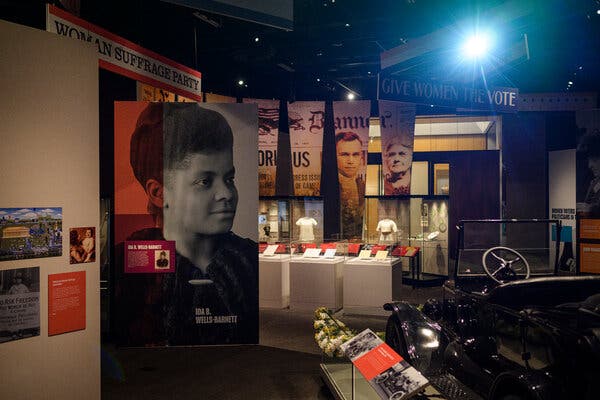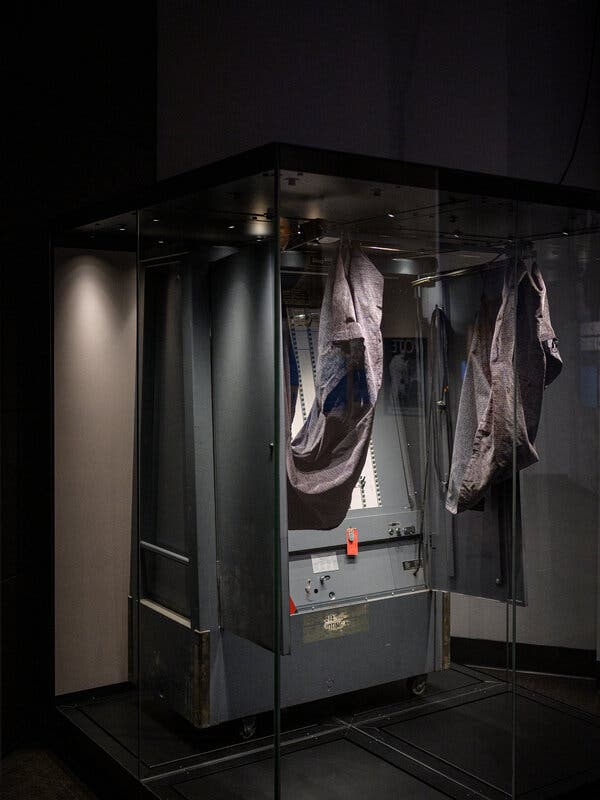How Tennessee Ratified the 19th Amendment – The New York Times
How Tennessee Ratified the 19th Amendment The New York Times

Advertisement
On Aug. 18, 1920, a young state legislator listened to his mama, and Tennessee became the final state to ratify the 19th Amendment.

NASHVILLE — Tuesday marks 100 years since the Tennessee General Assembly voted to ratify the 19th Amendment, which gave American women the right to vote and shifted the national political landscape as thoroughly as any earthquake, tornado, and tidal wave combined.
By Aug. 18, 1920, more than a year had passed since the United States Congress voted to approve the amendment. Thirty-five of the necessary 36 states had already voted for ratification, but there the women’s suffrage effort had stalled. Tennessee was ratification’s last viable hope before the 1920 election, and possibly for the foreseeable future.
In a story that is legendary here, the final vote came down to the conscience of one man: Harry T. Burn, a state representative from McMinn County, who was all of 24 years old. Mr. Burn supported women’s suffrage personally, but his most vocal constituents did not and 1920 was an election year. When the governor called a special session of the legislature to consider a motion to ratify the amendment, Mr. Burn headed to Nashville hoping to avoid a vote altogether.
In the sweltering month of August, in an overdressed age without air-conditioning, the Tennessee Senate passed the motion to ratify with a comfortable margin, but legislators in the House engineered one delay after another. As the hot days wore on, lobbying from both sides intensified. In what became known as the War of the Roses, supporters of suffrage wore yellow roses in their lapels; anti-suffragists wore red. Bribes were proffered, whiskey flowed, and previously stalwart supporters defected — legislators who wore a yellow flower on one day might be found wearing a red one the next.
On the 10th day of the special session, Mr. Burn received a letter from his mother, Febb Burn, a widow back home in Niota, Tenn. Mrs. Burn urged her son to “be a good boy” and vote for ratification.

That morning Mr. Burn, a red rose in his lapel, twice voted to table the motion, but each of those votes ended in a tie. A tie in the actual vote on ratification would consign the motion to defeat, so Tennessee’s anti-suffragist Speaker of the House finally put the motion to ratify up for a vote. And that’s when Mr. Burn, with his mother’s letter in his pocket, switched sides. When the clerk reached his name in the roll-call vote, he responded with a quiet “Aye.”
Pandemonium ensued. Harry T. Burn had just broken the tie. The vote to ratify had surely passed.
But the drama didn’t end there. Moving down the roll, the clerk came to Banks Turner, a House member from West Tennessee who had voted with the suffragists earlier in the day. This time, however, Mr. Turner sat silent when his turn came to vote. His silence created yet another tie.
As nay vote followed nay vote, anti-suffragists rose to their feet, already tasting victory. But after the roll call was complete, Mr. Turner finally spoke. “Mr. Speaker,” he said, “I wish to be recorded as voting Aye.”
“There was a long moment of silence, silence and shock,” writes Elaine Weiss in “The Woman’s Hour,” her lively, page-turning account of that summer. “Then an explosion, a roar never before heard in the old statehouse. The chamber shook with screams and cries, with thumping and whooping.” At the very last possible second, Tennessee had just voted to ratify the 19th Amendment.
The story, of course, is longer and more complicated than a newspaper column allows, certainly more than fond stories of politically engaged mothers and dutiful sons can account for. As Ms. Weiss notes, the fight for women’s suffrage didn’t end on Aug. 18, 1920. This anniversary has given Nashville an opportunity to provide a fuller picture of the legendary events that happened here 100 years ago.
There have been exhibits and special events at the historic Hermitage Hotel, where so much of the lobbying took place in 1920. A brilliant new documentary, “By One Vote,” by Nashville Public Television. A new suffrage monument by sculptor Alan LeQuire. An original opera by the Nashville Opera. Many of these commemorations, and so many others, have been put on hold during the pandemic, but some of them have been modified to allow for safe in-person attendance or have moved online.
At the Tennessee State Museum, which follows the governor’s plan for public buildings and is open to the public with special social-distancing guidelines, “Ratified! Tennessee Women and the Right to Vote” is a gorgeous two-gallery exhibit built from archival photos, physical artifacts, documents, and videos, including a wonderful clip from a television interview with Mr. Burn, recorded much later, who explains his reasons for casting a vote for ratification.
“Ratified!” tells a more complicated version of the suffrage story, going back much further than the vote for ratification. “One question we wanted to answer for visitors is why there was not a suffrage movement in Tennessee in the 1840s, when the national movement started,” curator Miranda Fraley-Rhodes told me last week on a tour of the exhibit last week. “And the answer to that is slavery. The suffrage movement really came out of the abolitionist movement, and in the South the whole culture was shaped by the institution of slavery.”
Tennessee, like the South as a whole, has a long history of suppressing the vote — a history that is ongoing. But at least some white suffragists here were advocating for interracial cooperation in securing the vote by 1920. The museum’s multimedia displays take special care to highlight the key contributions of Black women like Juno Frankie Pierce and Ida B. Wells. “In Nashville there was very much an effort between leading African-American suffragists and leading white suffragists to work together to help elect reform candidates,” according to Dr. Fraley-Rhodes. To make sure this history is available to Tennesseans who aren’t able to travel to Nashville, the museum has moved an interactive portion of the exhibit online and partnered with the Tennessee State Library and Archives and Humanities Tennessee (my former employer) to create what Ashley Howell, executive director of the museum, calls “an exhibit in a box” — eight panels that tell the story of suffrage and that can be mounted on the wall or on easels. Last week the exhibits were shipped, free of charge, to 87 locations around the state.
A few blocks down Rosa Parks Boulevard and up Church Street, the Nashville Public Library’s new Votes for Women room takes a very different approach to presenting and discussing issues raised by suffrage. Votes for Women is a permanent exhibit, with plans for its programming to evolve in response to contemporary issues and current events. Like the library’s magnificent Civil Rights Room, which it echoes in both design and intention, the new Votes for Women Room is partly about history and partly about how to interpret the current moment through the lens of history, said Andrea Blackman, director of both rooms, when she showed me around last week.
The centerpiece of the Votes for Women room is an eye-level timeline of photos depicting pivotal moments in the history of women’s quest for equality. The people in the photos are deliberately diverse, said Ms. Blackman: “We asked ourselves, ‘How do we balance race? How do we balance age?’ We want people to walk into this space and be able to see themselves.”
Above the timeline hangs a circle of statements by activists from the past hundred years. The first one you notice on entering the room is Gloria Steinem’s famous pronouncement, “Women have always been an equal part of the past. We just haven’t been a part of history.” Next to it is an equally famous exhortation from Shirley Chisolm: “If they don’t give you a seat at the table, bring a folding chair.”
The library, following the mayor’s reopening plan for public buildings during the pandemic, is currently closed to the public, so Votes for Women will launch online Tuesday, with appearances by Rosanne Cash and Nashville’s youth poet laureate, Alora Young.
Ms. Blackman, whose background is in education, is already busy sharing its treasures online and inspiring engagement with the questions the exhibit raises. “As long as people continue to push communities to change their thinking, or see that there’s another way to look at something, or challenge history, we’ll continue to have these tough conversations. Why not have them in a place where they can do research to support their arguments, where they can be supported in relating their ideas, and where they will have a backdrop of 100-plus years of activists who were asking those same questions?”
“I think, looking at the long history of women’s suffrage, what we can take away is that sometimes change happens over a very, very long period of time,” the University of Memphis historian Beverly Bonds observes in the Nashville Public Television documentary. “The wheel of progress just keeps right on turning — with a few maybe backward rotations, but it keeps turning.”
Margaret Renkl is a contributing opinion writer who covers flora, fauna, politics and culture in the American South. She is the author of the book “Late Migrations: A Natural History of Love and Loss.”
The Times is committed to publishing a diversity of letters to the editor. We’d like to hear what you think about this or any of our articles. Here are some tips. And here’s our email: letters@nytimes.com.
Follow The New York Times Opinion section on Facebook, Twitter (@NYTopinion) and Instagram.
